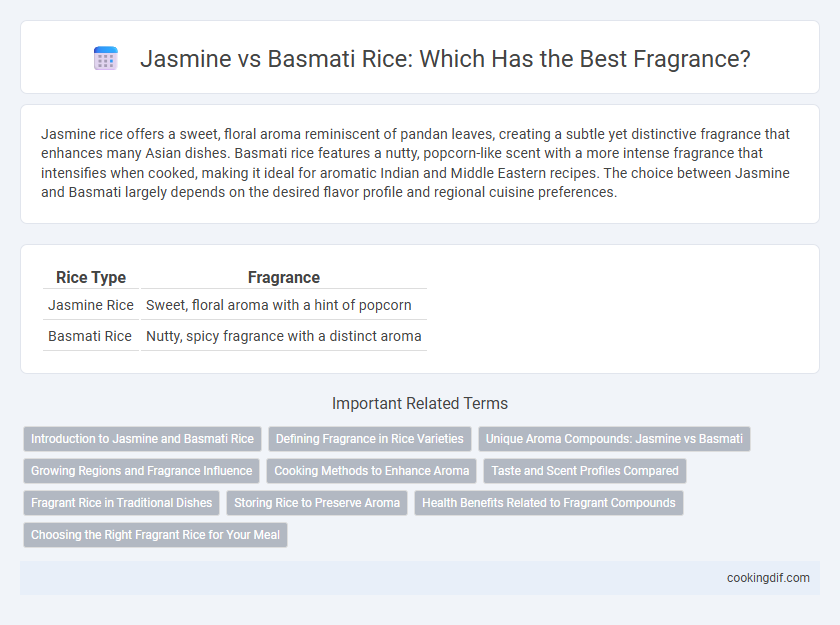Jasmine rice offers a sweet, floral aroma reminiscent of pandan leaves, creating a subtle yet distinctive fragrance that enhances many Asian dishes. Basmati rice features a nutty, popcorn-like scent with a more intense fragrance that intensifies when cooked, making it ideal for aromatic Indian and Middle Eastern recipes. The choice between Jasmine and Basmati largely depends on the desired flavor profile and regional cuisine preferences.
Table of Comparison
| Rice Type | Fragrance |
|---|---|
| Jasmine Rice | Sweet, floral aroma with a hint of popcorn |
| Basmati Rice | Nutty, spicy fragrance with a distinct aroma |
Introduction to Jasmine and Basmati Rice
Jasmine rice, primarily grown in Thailand, is celebrated for its naturally aromatic and floral fragrance, often described as pandan-like, which enhances the sensory experience of Southeast Asian cuisines. In contrast, Basmati rice, predominantly cultivated in the Indian subcontinent, features a distinct nutty and spicy aroma, prized in Middle Eastern and South Asian dishes. Both rice varieties are long-grain and prized for their unique scents that influence regional culinary traditions and flavor profiles.
Defining Fragrance in Rice Varieties
Jasmine rice is renowned for its naturally sweet and floral aroma, attributed to the compound 2-acetyl-1-pyrroline (2AP), which gives it a distinctive, fragrant scent reminiscent of pandan leaves and popcorn. Basmati rice also contains 2AP but offers a more nutty, spicy fragrance with a subtle earthiness, making its aroma more pronounced when cooked. The intensity and character of fragrance in these rice varieties are influenced by their unique genetic profiles and growing conditions, defining their sensory appeal in culinary applications.
Unique Aroma Compounds: Jasmine vs Basmati
Jasmine rice features a distinctive aroma dominated by pandan-like notes, largely due to the high concentration of 2-acetyl-1-pyrroline (2-AP), which imparts a sweet, floral scent. Basmati rice also contains 2-AP but combines it with other volatile compounds such as hexanal and nonanal, creating a complex, nutty fragrance with earthy undertones. The variation in these unique aroma compounds explains jasmine's bouquet reminiscent of tropical flowers versus basmati's robust, spicy aroma profile.
Growing Regions and Fragrance Influence
Jasmine rice, primarily cultivated in Thailand's northeastern provinces, gains its distinctive floral aroma from the tropical climate and rich, well-drained alluvial soils. Basmati rice, mostly grown in the fertile Indo-Gangetic plains of India and Pakistan, develops its unique nutty fragrance due to the elevated altitude, temperature variations, and soil composition rich in minerals. The terroir of these regions, including humidity and temperature, significantly influences the concentration of aromatic compounds like 2-acetyl-1-pyrroline, differentiating the fragrance profiles of Jasmine and Basmati rice.
Cooking Methods to Enhance Aroma
Jasmine rice releases its signature floral aroma best when steamed or cooked with a tight lid to trap the fragrance, while basmati rice benefits from rinsing and soaking to remove excess starch and enhance its nutty scent. Using a low simmer and allowing the rice to rest covered after cooking intensifies the natural fragrances of both jasmine and basmati. Toasting basmati grains before cooking develops a deeper aroma, whereas jasmine rice requires gentle handling to preserve its delicate floral notes.
Taste and Scent Profiles Compared
Jasmine rice offers a delicate, floral aroma with a subtly sweet taste profile that enhances Southeast Asian dishes, especially Thai cuisine. Basmati rice features a distinctive nutty fragrance and a slightly spicy flavor, complementing Indian and Middle Eastern recipes with its fluffy texture. The scent of jasmine rice is more perfumed and mellow, while basmati provides a stronger, aromatic fragrance, influencing the overall dining experience based on regional preferences.
Fragrant Rice in Traditional Dishes
Jasmine rice offers a delicate floral aroma that enhances Southeast Asian dishes such as Thai curries and Vietnamese pho, providing a subtly sweet fragrance that complements herbs and spices. Basmati rice, renowned for its nutty scent and long grains, is traditionally used in Indian and Middle Eastern cuisines like biryani and pilaf, where its aromatic profile intensifies the complexity of saffron and cardamom. Both fragrant rices elevate traditional dishes by infusing distinctive scents that enrich the overall sensory experience.
Storing Rice to Preserve Aroma
Jasmine rice retains its delicate floral fragrance best when stored in an airtight container away from moisture and heat, preserving its signature aroma for extended periods. Basmati rice, known for its nutty and aromatic scent, requires cool, dry storage conditions to maintain its fragrance and prevent spoilage. Properly storing both varieties in sealed, dark containers helps lock in essential oils that contribute to their distinctive aromas, ensuring a fresh, aromatic rice experience.
Health Benefits Related to Fragrant Compounds
Jasmine rice contains natural aromatic compounds like 2-acetyl-1-pyrroline (2-AP), which exhibits antioxidant properties that may support cellular health and reduce oxidative stress. Basmati rice also features 2-AP but often at a higher concentration, contributing to its stronger fragrance and potential anti-inflammatory benefits. Both rice varieties offer health advantages linked to their fragrant compounds, such as improved digestion and reduced risk of chronic diseases.
Choosing the Right Fragrant Rice for Your Meal
Jasmine rice features a floral, pandan-like fragrance that enhances Southeast Asian dishes, while Basmati rice offers a nutty, popcorn aroma ideal for Indian and Middle Eastern cuisine. Choose Jasmine rice for delicately scented meals that benefit from its soft, slightly sticky texture. Opt for Basmati rice when a distinct fragrance and fluffy grain separation complement rich spices and hearty recipes.
Jasmine vs Basmati for fragrance Infographic

 cookingdif.com
cookingdif.com